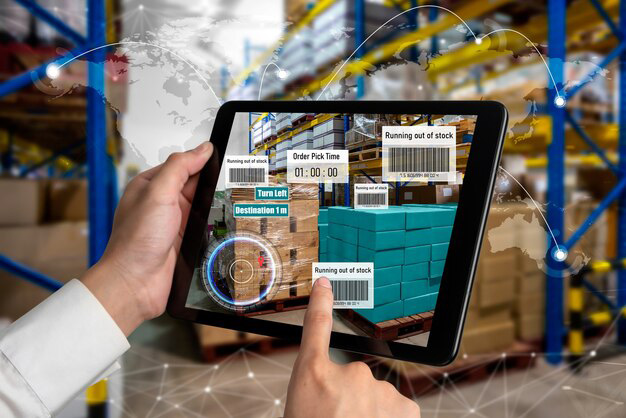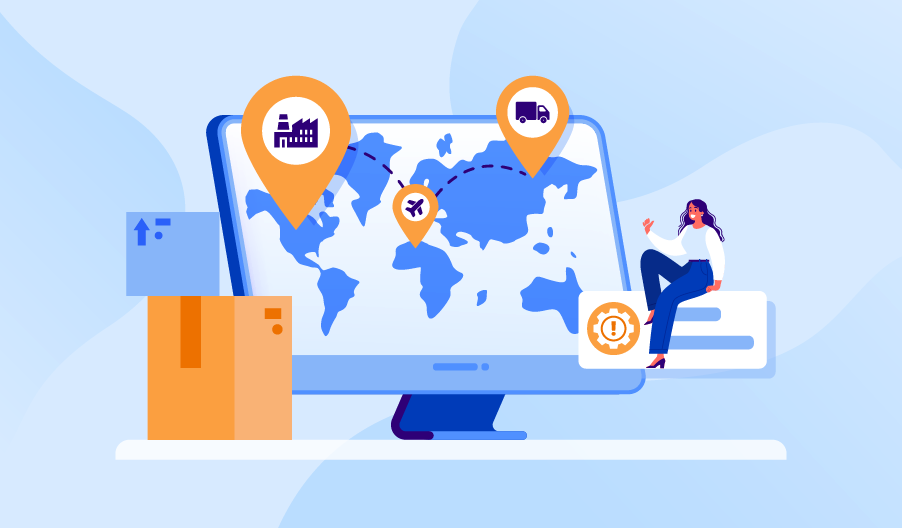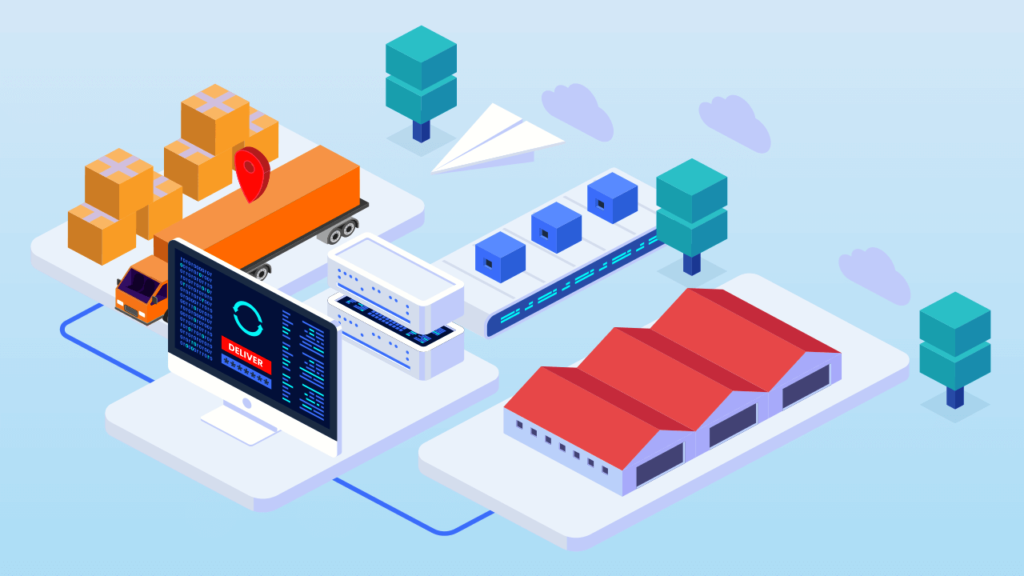
What is Supply Chain Management Software?
Supply Chain Management (SCM) software refers to digital solutions that help businesses manage the flow of goods, information, and finances across the entire supply chain. From procurement to production, warehousing, distribution, and delivery, SCM software integrates multiple processes to improve efficiency and minimize disruptions.
Companies that adopt supply chain management systems can enhance collaboration, forecast demand accurately, and respond swiftly to market changes. The right software gives companies the visibility they need to oversee suppliers, logistics, inventory, and delivery performance seamlessly.

Small companies often don’t separate the external and internal parts of product flow, so that the same specialist or department controls all phases goods and services pass through en route to the end customer. Large organizations usually split responsibilities between two executives — a supply chain manager and an operations manager.
What are the roles of a supply chain manager?
The top objective of both experts is to save expenses and boost efficiency of production without compromising on quality. But while a supply chain manager focuses on external processes, an operations manager solves pressing internal tasks. The former negotiates terms with third-party contractors (suppliers, logistics teams, distributors) and optimizes movement of materials and goods from one point to another outside the organization. The latter communicates with stakeholders and implements policies to boost manufacturing and get things working well inside the company.
Given that both pursue the same global goal and work on the same product, they have some overlapping responsibilities. For example, both are involved in:
- Forecasting prices, overseeing budgeting, planning and auditing.
- Cost management (estimating, controlling, optimizing, and reducing operating costs).
- Inventory control to ensure effective stock utilization and reduce warehousing costs.
- Demand forecasting, crucial for preventing overproduction and oversupply.
Supply chain and operations managers constantly exchange knowledge and information. Together, they reveal new opportunities for the company and address them. Within this ambitious aim, they take part in choosing innovative technologies that will reduce manual operations and automate stages of product flow.
Contract management. Among other things, the digital “administrator” helps you create and standardize contract templates, boosts approval processes, and captures electronic signatures.
Procure-to-pay (P2P) operations. P2P is a subdivision of procurement that covers financial transactions. The set of P2P features differs from product to product. But the core functionality usually boils down to managing a purchase requisition process, generating and tracking purchase orders (POs), and invoice matching. The system compares invoices to the corresponding POs to eliminate mistakes and duplication. If there are any deviations, the invoices are sent back to the supplier for corrections. Otherwise, payment is authorized.
Vendor (supplier) management. An app aggregates all data about your vendors, updates it, and alerts about expired qualifications and assessments. The performance of suppliers is measured against critical metrics such as speed, accuracy, quality, and price.

Spend analytics. The automated collecting, classifying, and analyzing of expenditure data brings visibility to the complex procurement process and allows businesses to discover savings opportunities.
Multi-location inventory tracking. Software allows for organizing and tracking inventory items by suppliers, serial numbers, tags, barcodes, SKUs (stock keeping units, or a number assigned to a product to track inventory) or other IDs at different location levels (bins, shelves, racks, aisles) across multiple warehouses. You can easily find a specific part or product, monitor locations, trace item transitions, view overstocks and stock outs.
Low inventory alerts. They appear in your dashboard when the quantity of certain items reach the preset low limit.
Automated replenishment. In case of frequent reorders, a replenishment tool can automatically create purchase orders and send them to vendors.
Digital FIFO tools. FIFO stands for first-in, first-out and describes the principle that the oldest inventory should be used or sold first. This approach leads to timely identification of the obsolete or slow-moving stock.
Barcoding. It involves both software and hardware (scanners and label printers) for assigning, scanning, and managing barcodes. Barcoding solutions bring ease, speed, and accuracy to your inventory operations such as stock-taking and verification.
Inventory optimization and performance analysis. The system automatically analyzes inventory data (such as sales history) and makes suggestions on replenishment dates and quantities. It also identifies the best performing products as well as ones with low profitability indicating where you make the most profit and which products face zero demand.
Real-time reporting. High-end solutions constantly process different metrics and generate visual reports on current inventory levels and turnovers, strengths and weak points.

Demand sensing. A demand planning system aggregates large volumes of real-time data from multiple sources to identify demand trends and generate accurate short-term forecasts. This enables you to react quickly when unexpected changes occur.
Demand segmentation and modeling. AI-powered software can optimize forecasts for different channels, products, customers, and more. Moreover, you can simulate multiple demand scenarios and analyze consumer buying patterns to make more informed decisions.
Resource planning. Based on demand forecasting, the software makes suggestions on the volumes of resources required to meet customer needs.
Collaborative forecasting. Suppliers, partners, and stakeholders can be brought into planning to develop forecasting in collaboration.
New product forecasting. The system analyzes sales history of similar products, considers different factors (like season, launch time, or region) and applies complex models to predict demand for new goods or services.
This list can be continued and extended as new technologies are emerging all the time, penetrating deeper into the complex processes and simplifying them. In our future posts we will keep you informed about innovations in the sector. And now, it’s time to move on to integrated SCM suites encompassing all mentioned-above solutions.
Supply Chain Management Systems: whether they fit your business needs
In contrast to SCM software products that focus on one particular task or niche, supply chain management systems (SCMS) are designed to coordinate the entire flow of products or, at least, a substantial part
Sometimes SCM systems include functions of Enterprise Resource Planning (ERP) software that optimizes internal tasks and processes, relevant to the operations management field. Vice versa, ERP suites often contain SCM tools and their functionality can be expanded by implementing compatible SCM add-ons.
To be more specific, let’s take a quick look at offerings from top SCM software vendors that lead the pack in terms of revenue and market share.

Implementing the right supply chain management software is no longer optional – it’s a necessity in today’s competitive landscape. Businesses that leverage advanced SCM software solutions enjoy greater efficiency, reduced costs, and better visibility throughout their operations. With trends like AI and IoT shaping the future, choosing the best supply chain management system in 2024 will give your business the competitive edge it needs to thrive.
How Supply Chain Management Software Works
SCM software acts as a bridge between all the participants in the supply chain, including manufacturers, suppliers, distributors, and customers. Here’s a breakdown of how these systems function:
Forecasts demand trends, helping businesses make data-driven decisions.
- Procurement and Supplier Management:
Streamlines purchasing decisions by analyzing supplier performance and pricing. Automates purchase orders and tracks supplier contracts.
- Inventory Management:
Provides real-time data on stock levels to prevent overstocking or shortages. Ensures balanced warehouse management by optimizing storage locations.
- Production Planning:
Synchronizes production schedules with demand forecasts to avoid delays. Automates production workflows for better resource management.
- Logistics and Distribution:
Tracks shipments in real-time and ensures on-time deliveries. Integrates with third-party logistics (3PL) services for seamless freight management.
- Data Analytics and Reporting:
Offers insights into operational performance with customizable dashboards.
Why Do Businesses Need SCM Software?
Supply chain disruptions have become more frequent due to global events, economic shifts, and fluctuating market trends. A digital supply chain management system helps businesses adapt quickly and ensures minimal disruption. Here are some key reasons why companies should invest in SCM software solutions:
1. Increased Efficiency and Automation
Manual processes are prone to human error, leading to costly delays. SCM software automates routine tasks like order processing and invoicing, reducing labor costs and improving speed.
2. Improved Supply Chain Visibility
One of the biggest advantages of SCM systems is real-time tracking. Companies can monitor inventory levels, shipments, and vendor performance from a single platform.
3. Cost Reduction
By optimizing inventory and improving logistics, companies can reduce operational expenses. Many SCM solutions also include features for better procurement, helping businesses negotiate better deals with suppliers.
4. Better Collaboration Across Departments
SCM systems improve collaboration by connecting different departments and stakeholders. Procurement, production, and distribution teams can access shared data and coordinate seamlessly.
5. Risk Management and Compliance
With automated monitoring tools, companies can identify potential risks early and take action to mitigate disruptions. SCM software also ensures compliance with industry regulations, preventing legal issues.

Top Features of the Best SCM Software
Choosing the right SCM solution requires knowing what features to look for. Here are the must-have capabilities for the best supply chain management software in 2024:
Real-Time Inventory Tracking:
Always know your stock levels with real-time data and alerts.
Advanced Forecasting Tools:
Predict demand accurately using AI and machine learning algorithms.
Cloud Integration:
Access your SCM system from anywhere with secure cloud hosting solutions.
Supplier and Vendor Management:
Evaluate and rank supplier performance to maintain strong partnerships.
Mobile Access:
Track your operations and make decisions on the go with mobile-friendly interfaces.
Customizable Dashboards:
Create visual reports tailored to your business’s needs.
The Future of Digital Supply Chain Management Software Solutions
The future of SCM software is closely tied to technological advancements. As businesses shift towards digital transformation, here are some trends shaping the SCM landscape in 2024 and beyond:
1. AI-Powered Automation
Artificial intelligence is enhancing forecasting capabilities and automating complex workflows, reducing the need for human intervention.
2. Blockchain for Transparency
Blockchain technology is improving trust across supply chains by offering transparent records of transactions and goods movement.
3. Internet of Things (IoT) for Real-Time Monitoring
IoT devices are revolutionizing how companies monitor shipments and track products across supply chains. Sensors and trackers help businesses respond to disruptions instantly.
4. Cloud-Based Collaboration
More companies are adopting cloud platforms for seamless collaboration among stakeholders, allowing them to respond quickly to changing market conditions.

How to Choose the Right SCM Software for Your Business
Selecting the right supply chain management system depends on your company’s size, industry, and operational needs. Here are some tips to help you make the best choice:
- Evaluate Your Business Needs:
Identify the specific pain points in your supply chain process. - Set a Budget:
Determine how much you can invest in software and implementation. - Look for Scalability:
Choose a system that can grow with your business. - Check for Integration Options:
Ensure the software integrates with your existing tools like ERP or CRM systems. - Read User Reviews and Ratings:
Learn from other businesses’ experiences with the software.

The Benefits of Digital Supply Chain Management (SCM) Software Solutions
Investing in digital SCM solutions brings a multitude of benefits, such as:
- Faster Decision-Making:
With real-time data, businesses can make quick and informed decisions. - Reduced Operational Costs:
Optimize resources and cut unnecessary expenses. - Enhanced Customer Satisfaction:
Deliver products on time and maintain high service standards. - Greater Flexibility:
Respond faster to market shifts and customer demands.
Supply Chain Management Features at a Glance

Inventory Management

Order Management

Procurement & Supplier Management

Demand Forecasting & Planning

Logistics & Transportation

Warehouse Management System (WMS)

Real-Time Visibility

Performance Measurement & Analytics
Frequently asked questions :
What is supply chain management software?
Supply chain management software is a computer program designed to help businesses manage their supply chain operations, including inventory management, order processing, logistics, transportation, and supplier management.
What are the benefits of using supply chain management software?
Some benefits of using supply chain management software include increased efficiency and accuracy in managing inventory and orders, improved visibility and control over supply chain operations, better collaboration and communication with suppliers and partners, and enhanced customer service and satisfaction.
What features should I look for in supply chain management software?
Some important features to look for in supply chain management software include inventory management and tracking, order processing and fulfillment, logistics and transportation management, supplier management, reporting and analytics, and integration with other business software.
Can supply chain management software be customized?
Yes, many supply chain management software solutions can be customized to meet the specific needs of a particular business or industry.
How much does supply chain management software cost?
The cost of supply chain management software can vary widely depending on the specific features and functionality offered, as well as the size and needs of the business. Some programs may be free or low-cost, while others can cost thousands or even millions of dollars.
Can supply chain management software integrate with other business software?
Yes, many supply chain management software solutions can integrate with other business software, such as ERP software, CRM software, and e-commerce platforms.
Is it difficult to learn how to use supply chain management software?
The difficulty of learning to use supply chain management software can vary depending on the specific program and the user's level of experience with supply chain operations. However, many programs offer user-friendly interfaces and tutorials to help new users get started.
Is it safe to store sensitive business data in supply chain management software?
Most supply chain management software solutions have robust security features to protect sensitive business data from unauthorized access or theft. However, it's important to choose a reputable program and to take appropriate measures to protect your data, such as using strong passwords and keeping your software up to date.
Can supply chain management software be accessed remotely?
Many supply chain management software solutions offer remote access, allowing authorized users to access the system from anywhere with an internet connection.
Can supply chain management software be used by businesses of all sizes?
Yes, supply chain management software can be used by businesses of all sizes, from small startups to large multinational corporations.

